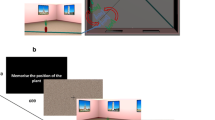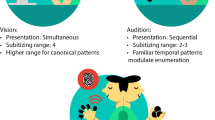Abstract
When dividing attention between the left and right sides of physical space, most individuals pay slightly more attention to the left side. This phenomenon, known as pseudoneglect, may also occur for the left and right sides of mental representations of stimuli. Representational pseudoneglect has been shown for the recall of real-world scenes and for simple, briefly presented stimuli. The current study sought to investigate the effect of exposure duration and complexity using adaptations of the Rey–Osterrieth figures. Undergraduates (n = 97) were shown a stimulus for 20 s and asked to remember it. Participants were then shown a probe and indicated whether it was the same or different. Results showed that, irrespective of whether an element was added or subtracted, changes on the left side of the remembered image were better detected. These results are consistent with representational pseudoneglect and demonstrate that this effect occurs for complex stimuli when presented for an extended period of time. Representation neglect is therefore unlikely to be the result of an initial saccade to the left—but could be related to the formation or recall of the representation.



Similar content being viewed by others
References
Adair JC, Barrett AM (2008) Spatial neglect: clinical and neuroscience review. Ann N Y Acad Sci 1142:21–43
Bisiach E, Luzzatti C (1978) Unilateral neglect of representational space. Cortex 14(1):129–133
Bowers D, Heilman KM (1980) Pseudoneglect: effects of hemispace on a tactile line bisection task. Neuropsychologica 18:491–498
Brooks JL, Brandimonte M (2014) Left-ear-driven representational pseudoneglect for mentally represented real-world scenes created from aural–verbal description. Cogn Process 15(2):201–207
Brooks JL, Logie RH, McIntosh RD, Della Sala S (2011) Representational pseudoneglect for an auditory-driven spatial working memory task. Q J Exp Psychol 64(11):2168–2180
Charles J, Sahraie A, McGeorge P (2007) Hemispatial asymmetries in judgment of stimulus size. Percept Psychophys 69:687–698
Churches O, Loetscher T, Thomas NA, Nicholls MER (2016) Perceptual biases in the horizontal and vertical dimension are driven by separate cognitive mechanisms. Q J Exp Psychol. doi:10.1080/17470218.2015.1131841
Cole GG, Kentridge RW, Heywood CA (2004) Visual salience in the change detection paradigm: the special role of object onset. J Exp Psychol Hum Percept Perform 30:464–477
Dehaene S, Bossini S, Giraux P (1993) The mental representation of parity and number magnitude. J Exp Psychol Gen 122:371–396
Della Sala S, Darling S, Logie RH (2010) Items on the left are better remembered. Q J Exp Psychol 63(5):848–855
Dickinson CA, Intraub H (2009) Spatial asymmetries in viewing and remembering scenes: consequences of an attentional bias? Atten Percept Psychophys 71(6):1251–1262
Fink GR, Marshall JC, Shah NJ, Weiss PH, Halligan PW, Grosse-Ruyken M, Ziemons K, Zilles K, Freund H-J (2000) Line bisection judgments implicate right parietal cortex and cerebellum as assessed by fMRI. Neurology 54(6):1324–1331
Foxe JJ, McCourt ME, Javitt DC (2003) Right hemisphere control of visuospatial attention: line bisection judgments evaluated with high-density electrical mapping and source analysis. NeuroImage 19:710–726
Gobel SM, Calabria M, Farne A, Rossetti Y (2006) Parietal rTMS distorts the mental number line: simulating ‘spatial’ neglect in healthy subjects. Neuropsychologica 44:860–868
Innes BR, Burt DM, Birch YK, Hausmann M (2015) A leftward bias however you look at it: revisiting the emotional chimeric face task as a tool for measuring emotion lateralization. Laterality 28:1–19
Iyilikci O, Becker C, Güntürkün O, Amado S (2010) Visual processing asymmetries in change detection. Perception 39:761–769
Jewell G, McCourt ME (2000) Pseudoneglect: a review and meta-analysis of performance factors in line bisection tasks. Neuropsychologia 38:93–110
Kinsbourne M (1993) Orientational bias model of unilateral neglect: evidence from attentional gradients within hemispace. In: Robertson IH, Marshall JC (eds) Unilateral neglect: clinical and experimental studies. Erlbaum, Hillsdale, pp 63–86
Mattingley JB, Bradshaw JL, Nettleton NC, Bradshaw JA (1994) Can task specific perceptual bias be distinguished from unilateral neglect? Neuropsychologica 32:805–817
Mattingley JB, Berberovic N, Corben L, Slavin MJ, Nicholls MER, Bradshaw JL (2004) The greyscales task: a perceptual measure of attentional bias following right hemisphere damage. Neuropsychologia 42:387–394
McCourt ME, Jewell G (1999) Visuospatial attention in line bisection: stimulus modulation of pseudoneglect. Neuropsychologia 37:843–855
McCourt ME, Blakeslee B, Padmanabhan G (2013) Lighting direction and visual field modulate perceived intensity of illumination. Front Psychol 4(983):1–6
McGeorge P, Beschin N, Colnaghi A, Rusconi ML, Della Sala S (2007) A lateralised bias in mental imagery: evidence for representational pseudoneglect. Neurosci Lett 421(3):259–263
Mesulam MM (1981) A cortical network for directed attention and unilateral neglect. Annals of Neurology 10(4):309–325
Neisser U (1967) Cognitive psychology. Appleton, New York
Nicholls MER, Bradshaw JL, Mattingley JB (1999) Free-viewing perceptual asymmetries for the judgement of shade, numerosity and size. Neuropsychologia 37:307–314
Nicholls MER, Loftus A, Gevers W (2008) Look, no hands: a perceptual task shows that number magnitude induces shifts of attention. Psychon Bull Rev 15:413–418
Nicholls MER, Thomas NA, Loetscher T, Grimshaw G (2013) The Flinders Handedness survey (FLANDERS): a brief measure of skilled hand preference. Cortex 49:2914–2926
Nuthmann A, Matthias E (2014) Time course of pseudoneglect in scene viewing. Cortex 53:113–119
Oliveri M, Rausei G, Koch G, Torriero S, Turriziani P, Caltagirone C (2004) Overestimation of numerical distances in the left side of space. Neurology 63:2139–2141
Osterrieth PA (1944) Filetest de copie d’une figure complex: contribution a l’etude de la perception et de la memoire. Arch Psychol 30:286–356
Posner MI (1980) Orienting of attention. Q J Exp Psychol 32(1):3–25
Rey A (1941) L’examen psychologique dans les cas d’encephalopathie traumatique. (Les problems.). Arch Psychol 28:215–285
Rinaldi L, Di Luca S, Henik A, Girelli L (2014) Reading direction shifts visuospatial attention: an interactive account of attentional biases. Acta Psychol 151:98–105
Roman A, Fathi AE, Santiago J (2013) Spatial biases in understanding descriptions of static scenes: the role of reading and writing direction. Mem Cogn 41(4):588–599
Siman-Tov T, Mendelsohn A, Schonberg T, Avidan G, Podlipsky I, Pessoa L, Gadoth N, Ungerleider LG, Hendler T (2007) Bihemispheric leftward bias in a visuospatial attention-related network. J Neurosci 27:11271–11278
Spotorno S, Faure S (2011a) Change detection in complex scenes: hemispheric contribution and the role of perceptual and semantic factors. Perception 40:5–22
Spotorno A, Faure S (2011b) The right hemisphere advantage in visual change detection depends on temporal factors. Brain Cogn 77:365–371
Vos L, Whitman D (2014) Maintaining perceptual constancy while remaining vigilant: left hemisphere change blindness and right hemisphere vigilance. Laterality 19(2):129–145
Yantis S (1993) Stimulus-driven attentional capture. Curr Dir Psychol Sci 2:156–161
Zorzi M, Priftis K, Meneghell F, Marenzi R, Umilta C (2002) Neglect disrupts the mental number line. Nature 417:138–139
Author information
Authors and Affiliations
Corresponding author
Electronic supplementary material
Below is the link to the electronic supplementary material.
Rights and permissions
About this article
Cite this article
Aniulis, E., Churches, O., Thomas, N.A. et al. Representational pseudoneglect for detecting changes to Rey–Osterrieth figures. Exp Brain Res 234, 3381–3387 (2016). https://doi.org/10.1007/s00221-016-4735-0
Received:
Accepted:
Published:
Issue Date:
DOI: https://doi.org/10.1007/s00221-016-4735-0




